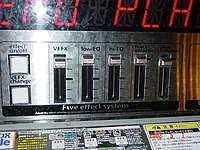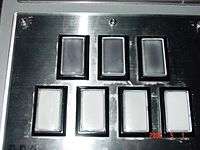Beatmania IIDX
Beatmania IIDX[lower-alpha 1] is a series of rhythm video games, that was first introduced by Konami in Japan on February 26, 1999.[2] IIDX has since spawned 27 arcade releases and 14 console releases on the Sony PlayStation 2.[3] It is the sequel to the beatmania game series,[4] and part of the Bemani line of music games.[5] A PC release titled beatmania IIDX INFINITAS has been announced, and began alpha testing in September 2015.[6]
| Beatmania IIDX | |
|---|---|
 A cabinet running beatmania IIDX 15 DJ TROOPERS | |
| Genre(s) | Music |
| Developer(s) | Bemani |
| Publisher(s) | Konami |
| First release | Beatmania IIDX
|
| Latest release | Beatmania IIDX 27: Heroic Verse[1]
|
Gameplay
Gameplay in general

Beatmania IIDX tasks the player with performing songs through a controller consisting of seven key buttons and a scratchable turntable.[7] Hitting the notes with strong timing increases the score and groove gauge bar, allowing the player to finish the stage. Failing to do so depletes the gauge until it is empty, abruptly ending the song.[8]
Starting from beatmania IIDX 17 SIRIUS, two new note types are added. Charge Notes is a note that must be pressed and released on the right time, while Backspin Scratch is a scratch note which require the player to spin the disc in a direction, then spinning it in the opposite direction at the end. Both are valued two combos; one for the beginning note and one for the ending note. beatmania IIDX 23 copula introduced a variation called Hell Charge Notes, which refill the gauge when held down but rapidly deplete it when not. Unlike regular Charge Notes, they can be pressed at any time, though missing the timing window will still break the player's combo.
Difficulty
From beatmania IIDX to beatmania IIDX 4th Style, song difficulty ranged from Level 1 to Level 7. beatmania IIDX 5th Style introduced flashing Level 7s as the new top difficulty. Flashing 7s gave way to Level 8 difficulty in beatmania IIDX 10th Style, and Level 8+ was added in beatmania IIDX 11 IIDXRED. The version immediately after, beatmania IIDX 12 HAPPY SKY, introduced a new difficulty scale, from Level 1 to Level 12, which has remained the standard.
Extra stage system
Like most BEMANI titles, Beatmania IIDX has Extra Stage and One More Extra Stage songs, commonly known as ES and OMES respectively. When Extra Stage was introduced in beatmania IIDX 3rd Style, there was no new song to unlock, and the player simply got to play an extra song. beatmania IIDX 7th Style was the first to have an unlockable song only available on Extra Stage, and also introduced the One More Extra Stage. Obtaining the secret ES and OMES required meeting certain requirements during a session of play. beatmania IIDX 13 DistorteD was the first title with an Extra Stage system exclusive to players using an e-AMUSEMENT pass; it also included multiple Extra Stages that had to be cleared under certain requirements to unlock the One More Extra Stage.
beatmania IIDX 14 GOLD saw the return of the standard ES and OMES songs, alongside another multiple Extra Stage system. The setup of having two systems per game (standard system and e-AMUSEMENT system) continued until beatmania IIDX 18 Resort Anthem, where the standard ES and OMES stood alongside a new song unlock system tied to a player's e-AMUSEMENT pass. beatmania IIDX 19 Lincle brought back the multiple Extra Stage system, in the form of Lincle Kingdom, while retaining the standard ES and OMES setup. beatmania IIDX 20 tricoro replaces the standard Extra Stage with "LIMIT BURST", which allows seven different Extra Stage songs to be played. There are no One More Extra Stages for LIMIT BURST, and so far, the only OMES was Plan 8, part of tricoro's first song unlock system, LEGEND CROSS.
Most Extra Stage songs debut in their respective Beatmania IIDX games, but there are some Extra Stage songs (esp. from the multiple Extra Stage systems) that are crossovers from other BEMANI titles; for example, tricoro's LIMIT BURST system is largely made up of notably difficult songs from other games. Examples include "neu" from pop'n music 15 ADVENTURE, "JOMANDA" from jubeat copious, and "New Decade" from Dance Dance Revolution X2, which got a specially cut version of the song for its IIDX chart.
History
In 1997, Konami distributed its Games & Music Division's (G.M.D.) Beatmania in Japan as a DJ-themed arcade title, significantly influencing rhythm games. Its surprise success influenced the developer to rename itself Bemani, a portmanteau of "Beatmania", and the studio made several spinoffs following its release, including Pop'n Music and Dance Dance Revolution.[8][9]:54–58[10]:297 Bemani initially conceived and developed Beatmania IIDX as a sequel to Beatmania, and Konami released it in Japan in 1999. The development team designed the game to simulate the experience of an actual DJ performing music at a real venue, and gave it a "club Visual Jockey feel."[11] While its predecessor used five keys, IIDX's controller had seven of them.[12] The controller was integrated into the game's Benami Twinkle cabinet along with a large 40-inch widescreen monitor, massive speakers, and eight spotlights.[11]
The original IIDX gained a post-release reception from video game publications. Neil Foster, writing for the website Hardcore Gaming 101, stated that with the addition of a widescreen monitor, the upper keys were made easier to identify. He called the game "a rocky start" for the Beatmania IIDX series, since it had music from Beatmania's first two iterations (1st Mix and 2nd Mix) paired with new tracks and remixes. According to Foster, many players were initially not impressed with performing old songs on upgraded hardware, so they switched to Beatmania 4th Mix.[7] Bryn Williams of GameSpy found IIDX to be harder than the original Beatmania, because songs that take advantage of its seven keys have more notes than those made for five keys.[12] IGN's Chris Roper wrote that it was successful because of its distinctive and responsive controller. He opinioned that the controller was imperfectly designed, yet its implementation made the game a rare experience.[8]
Bemani developed several updates to the game after its release. Konami decided to link Beatmania IIDX Club Version (later Substream) cabinets with Dance Dance Revolution 2ndMix machines for simultaneous play, leading to increased success. In late 1999, the publisher hired artist Goli to design graphics and characters for Beatmania IIDX 2nd Style.[7] The next game in the IIDX series, 3rd Style, featured a new aesthetic and was ported to the PlayStation 2.[13] In 2002, 8th Style was released after the discontinuation of the original five-key Beatmania. Foster said the updates popularized the game to the point that it overshadowed Beatmania, and IIDX earned more new songs and became known for being very difficult.[7] A sequel with a five-key controller, Beatmania III, was released in 2000.[14]
A video game named Beatmania was released in North America in 2006.[8] In 2015, a PC release titled beatmania IIDX INFINITAS was announced, and began alpha testing in September.[6] On January 29, 2020, Heroic Verse's LIGHTNING MODEL cabinets received a North American release.[15]
Hardware

The beatmania IIDX cabinet has many standard features that are found in traditional arcade cabinets such as a widescreen display, powerful speakers, and start buttons. Also, unique to IIDX cabinets are the effector buttons and sliders, a bass platform transducer, marquee, and DJ simulating controller. The effector buttons and sliders allow the player to control the volume levels within the game and manipulate the music by adding additional sound effects. The bass platform vibrates beneath the player's feet to the beat of the music being played. The marquee is a series of sixteen-segment display LEDs, used to display game information and scores during gameplay.[11]
Controller information


beatmania IIDX controls consist two sets of seven keys on each player's side, along with two turntables. The turntable for the left player's side is to the left of the keys, while the one on the right player's side is to the right.[11]
Each set of keys is arranged in a pattern of four white keys beneath three black keys. The black keys are offset from the white keys so that each pair of adjacent white keys has a black key above and in between them. This arrangement mimics the F, F#, G, G#, A, A#, B keys on a musical keyboard, though beatmania keys, being about twice as long as they are wide, do not resemble piano keys. The keys are commonly numbered 1 through 7, from left to right. The four white keys are numbered 1, 3, 5, and 7; the three black keys are numbered 2, 4, 6.
As of Cannon Ballers, two cameras are installed, one on the metal cage pointing to the controls and other at left pointing to the players. Initially the game would not boot up if the cameras weren't attached; this was fixed after initial release. As of Rootage, the left camera can read QR codes.
As of Heroic Verse, a new cabinet called LIGHTNING MODEL has been introduced. The effect sliders, LCD marquee and keypads have been replaced with a touchscreen called the Premium Area, located under the screen where the sliders used to be. Due to the removal of the slider panel, the start buttons have been relocated to the upper-left and upper-right of the 1P and 2P keys respectively, and the VEFX and EFFECT buttons are located above the coin slot, as with 5-key beatmania machines.[16]
e-amusement
Since 9th Style, the game has featured integration with Konami's e-amusement platform, which uses a card inserted at the beginning of the game to save stats, scores, allow customization, and track scores in comparison to previous plays and against others over the internet. From 9th Style to Happy Sky (12th), this was by way of a magnetic card and reader.[17] From Distorted onwards the newer type Contactless smartcard Konami e-amusement Pass system has been used. 9th Style did not require an internet connection to use a subset of the e-amusement functionality, but 10th and on required an internet connection to function, which must be provided by a subscription from Konami. e-amusement is not available outside of the primary markets for IIDX (Japan, Asia, and the United States), which has left imported machines outside of Asia without full access to hidden songs and extra stages due to the increasing functionality and integration of e-amusement in more recent styles. However, new songs from e-amusement enabled styles can still be accessed on console versions (which can be imported from Japan). As of Tricoro, required an internet connection to startup instead. As of Rootage, offline kits are returned.
Home versions


Konami also released home versions of IIDX for the PlayStation 2 console in Japan.[13] The home versions are known as CS (consumer software or console) styles, while the arcade versions are known as AC (arcade cabinet or arcade) styles. The CS games can be played with a DualShock controller or with a special controller from Konami that recreates the arcade experience. Konami manufactures two forms of home controllers, which are known as Konami Official Controllers (KOC) and Arcade Style Controllers (ASC). The KOC, pictured above, is much cheaper than the ASC, but is smaller than the ASC. In addition, KOCs look very different from ASCs and have a smaller space between the turntable and the keys. Konami purports the ASCs to be "arcade-accurate," in that they both resemble and feel like a controller on an arcade machine. For example, the controller itself is much larger and has the turntable further away from the keys. Both styles have a detachable key panel that can be placed to the left or the right of the turntable as the player desires. Aftermarket controllers are also readily available, often containing lit turntables and keys.
Each CS style corresponds to an AC style of the game and usually contains every song that debuted on its respective AC style. However, some songs have copyright issues with CS, mobile or Infinitas' releases. In addition, CS styles may feature a selection of "revivals" - songs that appeared on previous AC or CS styles, "preview songs" - songs that appear on AC styles that do not yet have corresponding CS styles, and "CS exclusive" songs that appear only on CS styles. As of October 2009, CS versions of 3rd Style through Empress have been released (note that 3rd CS contains songs from 1st through 3rd AC; thus, there are no 1st style, 2nd style, or Substream CS titles); additionally, there is a PC title, Beatmania IIDX Infinitas, that doesn't correspond to any AC style however, is very closely related to Sirius in look and feel.[6]
From October 1998 to March 31, 2007, Beatmania's PlayStation ports sold more than one million copies.[18]
Music
Music is an integral part of the beatmania IIDX series. Featuring a wide selection of genres and artists, both licensed and in-house, the Beatmania IIDX series is well known for its original music.[13] Konami produces an original soundtrack of each game, usually a few months after release, due to the appeal of the music. Konami also releases original albums by Beatmania IIDX artists through its online store, Konamistyle. It's also a tradition that Konami crossovers some songs from other Bemani games such as Pop'n Music or Dance Dance Revolution.
Each new AC release typically features around 60-100 new songs (110 in Rootage), with a selection of songs returning from previous versions and some songs have LEGGENDARIA charts. The current release, beatmania IIDX 27 Heroic Verse, features a library of over 1000 songs. Some songs are splitted across difficulties or styles. CS releases feature all of the new songs of their corresponding AC versions (with limited exceptions), 5-10 CS exclusive songs, around 25 "revival" (returning) songs, and 1-3 preview songs, for a total of around 60-100 songs (Empress use 2 discs that have 99 songs per disc). Arcade versions since 9th Style run on Bemani PC, rather than the DVD-based Bemani Twinkle, and thus have more space in which to store data.
Songs often include music videos when played, although only some songs contain dedicated videos. Some songs contain generic videos shared by multiple songs, and some of these have additional animated graphics overlaid atop them. Beginning with beatmania IIDX 19 Lince, players can select Qpro characters or customize them, and some songs show Qpros as part of overlays. Beginning with beatmania IIDX 20 tricoro, overlays of some songs were removed, and in beatmania IIDX 9th Style, the effector system is not available, both due to hardware limitations. Beginning with beatmania IIDX 25 CANNON BALLERS, the effector system is expanded to 8 effect options, adjunt with EQ ONLY. In mobile games and in beatmania IIDX Infinitas, the effector system is disabled.
Releases
The beatmania IIDX series has been released in the home video game market in addition to its arcade releases. To date, the only video game system to have seen a IIDX game is the Sony PlayStation 2. There are currently fourteen games that have been released for the Japanese PlayStation 2, 3 mobile games, one PC game (beatmania IIDX Infinitas)[6] and one game for the American PlayStation 2 (beatmania).[8]
Arcade versions of beatmania IIDX have been imported to the United States from Japan during its lifetime. However, the latest release (beatmania IIDX 27 HEROIC VERSE), in LIGHTNING MODEL cabinet format, is the first time the game has seen a dedicated North American build specifically for use in the United States.[15]
See also
Notes and references
Citations
- https://p.eagate.573.jp/game/2dx/27/top/index.html
- "beatmania IIDX - beatmania IIDX for JP Arcade Game Information". bemanistyle.com. Archived from the original on 2008-01-09. Retrieved 2009-05-25.
- "beatmania IIDX GATEWAY" (in Japanese). Konami. Archived from the original on 9 June 2009. Retrieved 2009-05-26.
- Roper, Chris (March 28, 2006). "beatmania - There isn't a whole lot of rhythm in Konami's latest music game". IGN. Retrieved 2009-05-25.
- "BEMANI Portal" (in Japanese). Konami. Archived from the original on 9 June 2009. Retrieved 2009-05-25.
- "PC版『beatmania IIDX』発表、急遽αテストがスタート…9月2日20:00まで". インサイド. September 2, 2015.
- Foster, Neil (April 1, 2013). "Beatmania (page 8)". Hardcore Gaming 101. Kontek. Archived from the original on July 23, 2019. Retrieved March 5, 2020.
- Roper, Chris (March 28, 2006). "beatmania". IGN. Ziff Davis. Retrieved March 7, 2020.
- Ashcraft, Brian; Snow, Jean (2008). Arcade Mania! The Turbo-Charged World of Japan's Games Centers. Kodansha International. ISBN 978-4-7700-3078-8.
- Cook, Nicholas; Pettengill, Richard (May 16, 2013). Taking It to the Bridge: Music as Performance. University of Michigan Press. ISBN 9780472051779.
- "overall on beatmania IIDX". Konami. Konami. 1999. Archived from the original on February 6, 2007. Retrieved March 5, 2020.
- Williams, Bryn (April 5, 2006). "beatmania - Page 1". GameSpy. IGN Entertainment, Inc. Retrieved March 7, 2020.
- "BeatMania IIDX 3rd Style - PlayStation 2". GameSpy. IGN Entertainment, Inc. November 2, 2000. Retrieved March 15, 2020.
- "beatmania III". Konami. Konami. 2000. Archived from the original on December 4, 2004. Retrieved March 15, 2020.
- https://www.otaquest.com/beatmania-iidx-lightning-model-usa-build/
- https://www.konami.com/from_konami/movie_view.html?movie_url=6118344386001
- https://www.konami.com/amusement/products/am_bmiidx9/
- "SEC Info - Konami Corp - '20-F' for 3/31/07". SEC Info. Fran Finnegan & Company. March 31, 2007. Archived from the original on February 2, 2009. Retrieved March 5, 2020.
Bibliography
- Ashcraft, Brian (2008). Arcade Mania! The Turbo-Charged World of Japan's Games Centers. Kodansha International. ISBN 978-4-7700-3078-8.
- Cook, Nicholas; Pettengill, Richard (May 16, 2013). Taking It to the Bridge: Music as Performance. University of Michigan Press. ISBN 9780472051779.
External links
- Beatmania IIDX Gateway (in Japanese)
- Beatmania IIDX at the Killer List of Videogames
- Outphase, fan news site
- Solid State Squad, American-based Beatmania IIDX scorekeeping site.
- Beatmania IIDX Notecharts (in Japanese)